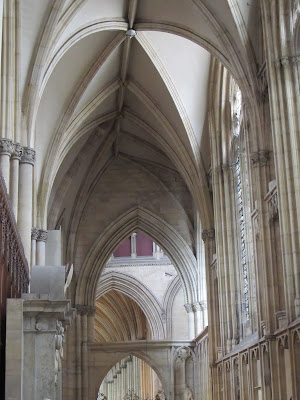I spent May 9 at a symposium about digital opera at the University of York. I’m still not sure what digital opera is, but neither is anybody else it seems. Are we talking about digital media in opera composition, performance, or distribution? All or none of the above? Should we use the term digital or digitized? And what exactly is an opera anyway? The composers, directors, and musicologists in attendance all have different views.
 After a day of mind-bending academic talk and some nifty music, I walked over to York’s medieval cathedral and found it bathed in golden light.
After a day of mind-bending academic talk and some nifty music, I walked over to York’s medieval cathedral and found it bathed in golden light.  |
| Close-up of the heart window |
I gladly spent the next morning in its soothing splendor. York’s minster (an old Anglo Saxon word for church) has been a place of worship since 627 CE. The current building was started in 1220 and took over 250 years to complete.
I took a guided tour that focused on the minster’s stunning windows. Some of the stained glass dates back to the 1200s.
The window below dates from 1260 and has over 100, 000 pieces. (You're seeing about a third of it.)
Some panels in other windows are being restored.
When a woman asked if the church was bombed during WWII, our guide told the follow story:
A number of years ago, I was leading a tour and the same question came up. A man in the crowd said, “I think I can answer that.” He had been a German bomber pilot. “We would follow the river up to York and see the church. So beautiful, so huge. Why would we want to bomb it? It was a fixed point for navigation.”
The east arm of the building is not quite in line with the rest of the nave. I did not notice this until the guide pointed it out.
In the crypt, you can see how the current building was built on top of a Norman church (c1080), which was built on top of a chapel (c700), which was built on top of a Roman fortress (c71 CE).
One sight at the University of York at the end of a long, word-filled day struck me as very funny: the soap dispensers in the restroom.
Just in case you forget where you are, I suppose? Or in order to get a deal on corridor signs you had to order the soap dispensers too?








No comments:
Post a Comment